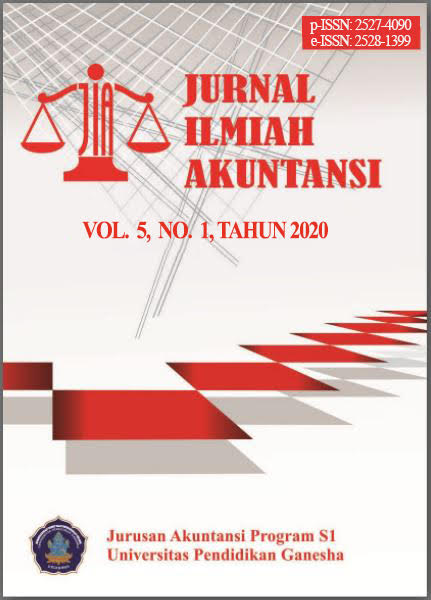Kinerja Keuangan: Intellectual Capital Performance dan Investment Opportunity Set
DOI:
https://doi.org/10.23887/jia.v5i1.24293Abstract
This study aims to examine the factors that affect financial performance, i.e. Intellectual Capital Performance measured using the Extended Value Added Intellectual Capital Plus and Investment Opportunity Set methods measured using investment-based joint proxy. The population used for the object of research is manufacturing sector companies listed on the Indonesia Stock Exchange in the 2014-2018 period. Based on the purposive sampling method, a sample of 15 companies was obtained with a study period of 5 years so that the research data amounted to 75 data. By using multiple linear regression analysis techniques, this study proves that the Intellectual Capital Performance and Investment Opportunity Set influences the positive and significant direction of Financial Performance. The results of the study indicate an increase in Intellectual Capital Performance and Investment Opportunity Set will improve the company's financial performance in the aspect of profitability.
References
Baber, W. R., Janakiraman, S. N., & Kang, S.-H. (1996). Investment opportunities and the structure of executive compensation. Journal of Accounting and Economics, 21, 297–318.
Bontis, N., Keow, W. C. C., & Richardson, S. (2000). Intellectual capital and business performance in Malaysian industries. Journal of Intellectual Capital, 1(1), 85–100.
Brigham, E. F., & Houston, J. F. (2011). Dasar-dasar Manajemen Keuangan Terjemahan. In 2 (11th ed., p. 184). Jakarta: Salemba Empat.
Christiningrum, M. (2015). Effect of Diversification Strategy, Leverage and IOS on Multi Segment Corporate Performance in Indonesia. Mediterranean Journal of Social Sciences, 6(5).
Gaver, J. J., & Gaver, K. M. (1993). Additional Evidence on the Association between the Investment Opportunity Set and Corporate Financing, Dividen, and Compensation Policies. Journal Of Accounting & Economics, 16, 125–160.
Hartono, J. (2016). Teori Portofolio dan Analisis Investasi (10th ed.). Yogyakarta: BPFE.
Herdinata, C. (2009). Kebijakan Pendanaan dan Dividen dengan Pendekatan Investment Opportunity Set. Jurnal Keuangan Dan Perbankan, 13(2), 237–248.
Hery. (2018). Analisis Laporan Keuangan. Jakarta: PT. Grasindo.
Jones, S., & Sharma, R. (2001). The Association Between the Investment Opportunity Set and Corporate Financing and Dividend Decisions: Some Australian Evidence. Managerial Finance, 27(3), 48–63.
Jumingan. (2014). Analisis Laporan Keuangan. Jakarta: Media Grafika.
Kallapur, S., & Trombley, M. A. (2001). The Investment Opportunity Set : Determinants, Consequences and Measurement. Managerial Finance, 27(3).
Keown, A. J., Martin, J. D., Petty, J. W., & Scott Jr, D. F. (2011). Manajemen Keuangan (10th ed.). Jakarta: Indeks.
Lukman, M. (2018). Keuangan Korporat. Jakarta: Bumi Aksara.
Marinda, F., AR, M. D., & Saifi, M. (2014). Pengaruh Investment Opportunity Set (IOS) dan Struktur Modal terhadap Kinerja Keuangan (Studi pada Perusahaan Sektor Properti dan Real Estate yang Terdaftar di Bursa Efek Indonesia Periode 2011-2013). Jurnal Administrasi Bisnis (JAB), 14(1), 1–10.
Munawir. (2014). Analisa Laporan Keuangan. Yogyakarta: Liberty.
Okefinance. (2017, June). Duh, Laba Bersih Siantar Top Turun Jadi Rp174,4 Miliar. Okefinance.
Rochmadhona, B. N., Suganda, T. R., & Cahyadi, S. (2018).
The Competitive Advantage between Intellectual Capital and Financial Performance of Banking Sector in ASEAN. Jurnal Keuangan Dan Perbankan, 22(2), 321–334.
Rosmaryam, Z. (2016). Investment Opportunity Set (IOS) dan Pengaruhnya terhadap Kualitas Laba. Jurnal FUTURE, 4(1), 120–141.
Saifi, M. (2019). The Effect of Corporate Governance and Investment Opportunity Set on Dividend Policy and Company’s Performance in Indonesia Manufacturing Company. Academy of Strategic Management Journal, 18(6).
Skinner, D. J. (1993). The investment opportunity set and accounting procedure choice. Journal of Accounting and Economics, 16, 407–445.
Sun, J., Lan, G., & Ma, Z. (2014). Investment opportunity set, board independence, and firm performance. Managerial Finance, 40(5), 454–468. https://doi.org/10.1108/MF-05-2013-0123
Ulum, I. (2017). Intellectual Capital (Model Pengukuran, Framework Pengungkapan, dan Kinerja Organisasi) (3rd ed.). Malang: UMM Press.
Ulum, I., Ghozali, I., & Purwanto, A. (2014). Intellectual Capital Performance of Indonesian Banking Sector: A Modified VAIC (M-VAIC) Perspective. Asian Journal of Finance & Accounting, 6(2), 103–123. https://doi.org/10.5296/ajfa.v6i2.5246
Ulum, I., Rizqiyah, & Jati, A. W. (2016). Intellectual Capital Performance: A Comparative Study between Financial and Non-Financial Industry of Indonesian Biggest Companies. International Journal of Economics and Financial Issues, 6(4), 1436–1439.
Wardiyah, M. L. (2017). Analisis Laporan Keuangan (1st ed.). Bandung: CV. Pustaka Setia.
Wiyono, G., & Kusuma, H. (2017). Manajemen Keuangan Lanjutan (1st ed.). Yogyakarta: UPP STIM YKPN.
Yuliana, I., & Khoiriyah, J. (2018). Modal Intelektual, Keunggulan Kompetitif, dan Kinerja Keuangan Pada Perusahaan High-IC Di Indonesia dan Singapura. JMM UNRAM, 7(4), 17–32. https://doi.org/10.29303/jmm.v7i4.343



1.png)


